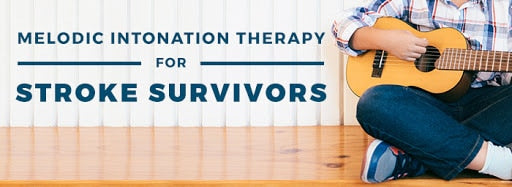Melodic Intonation Therapy for Stroke Survivors

Stroke is the leading cause of disability today. Many stroke survivors are left with a condition known as aphasia, a language disorder for which melodic intonation therapy may be a suitable treatment. Aphasia is most often associated with strokes that occur in the left side of the brain, as this is where the areas that control speech and language are found.
Two Types of Aphasia
Aphasia is categorized as either fluent or non-fluent. Fluent aphasia is also known as Wernicke’s aphasia because it affects Wernicke’s area in the brain. Patients suffering from fluent aphasia often can’t grasp the meaning of spoken words, while the ease of producing connected speech is not usually affected. However, their speech is far from normal sentences and irrelevant words are often spoken together.Reading and writing may also be compromised, and the person may not even be aware that there is an impairment.
Non-fluent aphasia, also called Broca’s aphasia after Broca’s area of the brain, is characterized by slow, effortful speech. Patients fully comprehend what others are saying and can read normally, but have trouble writing. Although only able to speak one or two words at a time; however, interestingly, many Broca’s aphasia patients can sing fluently.
What Is Melodic Intonation Therapy?
One of the few accepted treatments for severe, non-fluent aphasia is Melodic Intonation Therapy (MIT), a treatment that uses the musical elements of speech (melody and rhythm) to improve expressive language.
In MIT, patients repeat short, melodically intoned utterances. The therapy includes several therapeutic techniques, such as left hand tapping and reducing speech rate. Eventually, the therapist will reduce the support provided until the patient is able to produce a trained utterance independently. MIT aims to improve connected speech.
What Does Melodic Intonation Therapy Look Like?

Here are a few videos that demonstrate the process that is used during MIT:
MIT emphasizes the melodic patterns that already exist in normal speech. When people speak, there is an underlying melody to their speech, and this offers non-fluent aphasia patients a route to relearning how to speak fluently.
How MIT Works Inside the Brain
MIT utilizes four critical elements to produce specific therapeutic effects:
- Intonation – This emphasis on melody helps the patient to access certain parts of the right hemisphere of the brain that are still intact, reducing dependence on the left hemisphere, which is damaged.
- Left-Hand Tapping – Left-side movements stimulate the right hemisphere, and this tapping exercise engages the network in the brain that controls both hand and mouth movements. Tapping also paces the speaker and provides cueing for producing syllables.
- Inner Rehearsal – This part of the process specifically addresses the inability to sequence and implement motor commands. The therapist softly sings the phrase while the patient rehearses it mentally. This creates an “auditory target” that the patient can compare his or her voice to. Once a patient masters this, spontaneous verbal expression becomes possible with little or no assistance.
- Auditory-Motor Feedback Training – This element of therapy involves patients comparing their own speech to that of the therapist. Over time, with the use of the auditory-motor feedback loop to hear their own speech, patients learn to correct their own mistakes without needing the therapist on site.
As a whole, the treatment usually consists of three levels of treatment built around useful common words and phrases. As the therapy progresses, the phrases become longer. An example would be starting with “I love you,” progressing to “I love my children,” and finally to “I love my daughter and my son.” These phrases would be sung in two pitches, so that the patient’s voice rises and falls on specific words.
Who Can Receive Melodic Intonation Therapy and What Are Its Benefits?
A patient who has a good response to MIT will show an improvement in conversational speech skills. Patients who are most likely to respond well to this treatment have most or all of the following characteristics:
- A unilateral, left-hemisphere stroke
- Poorly articulated, non-fluent, or severely restricted speech output
- Ability to produce some intelligible words while singing familiar songs
- Poor repetition, even for single words
- Moderately well-preserved auditory comprehension
- Good motivation, emotional stability, and good attention span
There are cases where MIT has helped people who fall into this category regain their speech sometimes years after a stroke, even after receiving traditional speech therapy.
For non-fluent aphasia patients, regaining speech is the key to eliminating the disability, returning to productivity on the job, and reclaiming a high quality of life.
Here at Saebo, we are committed to stroke support and recovery for all survivors and their families. Saebo offers a wide range of products that combine cutting-edge technology with evidence-based rehabilitation techniques. Our offerings and network of Saebo-trained therapists can help you or a loved one to obtain all the necessary tools to maximize stroke recovery.
All content provided on this blog is for informational purposes only and is not intended to be a substitute for professional medical advice, diagnosis, or treatment. Always seek the advice of your physician or other qualified health providers with any questions you may have regarding a medical condition. If you think you may have a medical emergency, call your doctor or 911 immediately. Reliance on any information provided by the Saebo website is solely at your own risk.



